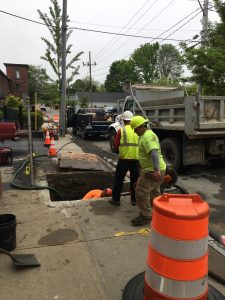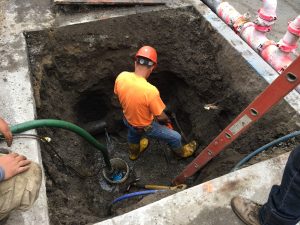
Knowledge Base / News
Your organization most likely has measures in place to help maintain your uptime. This is often contained within your business continuity plan, which should define the ways you are protecting your business against unexpected downtime. Your data is hopefully being backed up offsite, you have a firewall to protect your network, and you have documentation in place that outlines steps to take in event of various emergencies or downtime.
In most instances, unexpected downtime happens because of elements outside of your control. Extreme weather, power or Internet outages, and sometimes human actions can bring your organization to a halt.
One type of unexpected situation is one we almost ran into here at AVTECH last week – downtime due to construction.
 The dread of seeing a backhoe pull up
The dread of seeing a backhoe pull upSince this work is completely run by the municipality, we do not have any control over the work or the timing. As such, we also don’t have any control over the outcome, should their work lead to any accidents or mishaps.
It’s situations like these that can lead to unexpected but very real consequences when something happens, like a backhoe digging just a bit too far to one side and accidentally severing a major fiber line, bringing down your Internet and telephone service.
Or, construction could accidentally break a water main, causing thousands of gallons of water to flood the area and into your building. We’ve mentioned before that businesses are 10x more likely to suffer from flood damage than they are from fire damage, and construction accidents are one of the primary reasons why that can happen.
Power and electricity can also be drastically affected by a construction mishap; overhead wires as well as those buried underground can accidentally be cut, leading to your organization being completely down for hours, if not days.
Thankfully none of the above incidents happened here at AVTECH, but they very well likely could have. If any of them had occurred, we have multiple Room Alert environment monitors throughout our building that would have alerted our staff immediately to any problems.
 Flood sensors in multiple locations throughout the building would have triggered instant alerts if a water main break caused flooding within the office. Power sensors would have alerted us to any issues with power loss or backup power sources needing to kick in, and built-in temperature sensors in all Room Alert monitors would have alerted us to any escalating temperatures in sensitive areas like our data center that would have resulted from a power outage.
Flood sensors in multiple locations throughout the building would have triggered instant alerts if a water main break caused flooding within the office. Power sensors would have alerted us to any issues with power loss or backup power sources needing to kick in, and built-in temperature sensors in all Room Alert monitors would have alerted us to any escalating temperatures in sensitive areas like our data center that would have resulted from a power outage.
You can’t predict how outside forces may impact your business. This is why it’s so critical to include environment monitoring in your business continuity plan. Having a firewall, anti-virus software, and data backup procedures are all vitally important to maintaining uptime and protecting your organization in the event of an outage or emergency. Yet none of those will alert you to water being detected in your server room, or problems with your backup generator during a power outage. Nearly 30% of all outage episodes are caused by environment factors (of which outside construction is certainly one!) and it’s critical that your organization proactively monitor them.
Room Alert is an inexpensive, easy to use solution to help provide any organization with proactive environment monitoring. While you can’t control the actions of that giant backhoe just outside of your parking lot, you can control whether you’ll be notified immediately if that backhoe causes your building to flood or lose power.
Don’t wait until it’s too late! Install Room Alert in your facility to ensure 24×7 proactive monitoring of environment factors, and help increase your uptime immediately.

You may find Windows Command Prompt at the following path:
To run Windows Command Prompt as an administrator:
| Current S models | Current E models |
|---|---|
| Room Alert 32S | Room Alert 32E |
| Room Alert 12S | Room Alert 12E |
| Room Alert 3S | Room Alert 4E |
| Room Alert 3E | |
| S models | E & W models |
|---|---|
| Room Alert 32S | Room Alert 32E |
| Room Alert 12S | Room Alert 12E |
| Room Alert 3S | Room Alert 4E |
| Room Alert 3E | |
| Room Alert 3W |
| Model |
|---|
| Room Alert MAX |
| Room Alert 32S |
| Room Alert 12S |
| Room Alert 3S |
| Room Alert 32E/W |
| Room Alert 12E |
| Room Alert 4E |
| Room Alert 3E |
| Room Alert 3 Wi-Fi |